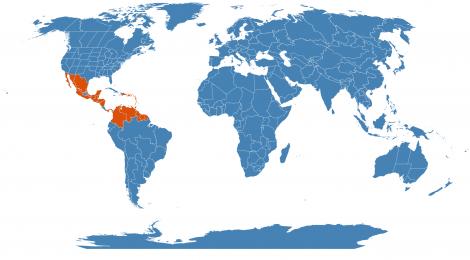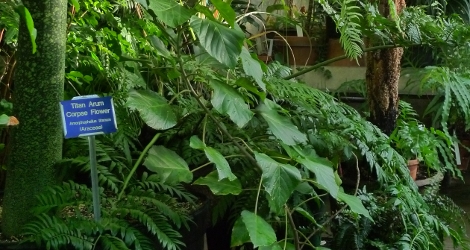Accession Data:
Brassavola cucullata (L.) R.Br.
subg. Brassavola sect. Brassavola
- Common Name: Hooded Brassavola
- Family: Orchidaceae Juss.
- Country of Origin: Mexico to N. South America, Caribbean

- Habitat: low-lying rain forests up to elevations of 7200 feet
- Culture: Brassavola cucullata need bright light and should be placed where they can receive plenty of light without long exposure to midday sun. These plants can be grown in an intermediate environment. Day temperatures should be 69-86 degrees with night temperatures of 55-65 degrees. Grow these plants in a mixture of fir bark with perlite with charcoal added or on slabs of bark. Fertilize weekly with a high nitrogen fertilizer diluted to ½ the strength recommended on the label. These plants benefit from high humidity which should be kept between 75-85% all year long. Water freely during the growth period and decrease waterings when new growth has matured. At this time give the plant only enough to keep the leaves from shriveling.4
Accession Data:
- Accession # 199300085
- Source: Vicki Wanlass
- Accession Date: 12-31-1993
- Bench: 3219 - ORCH:Nepenthes
- Currently: active - healthy
- Qty: 1 confirmed on 11-29-2024
- Restrictions:
- CITES Appendix II Listed Plant
- CITES Appendix II Listed Plant
Classification:
- Division: Magnoliophyta
- Class: Liliopsida
- SubClass: monocots
- Order: Asparagales
- SubOrder:
- Family: Orchidaceae
- SubFamily: Epidendroideae
- Tribe: Epidendreae
- SubTribe: Laeliinae
Flowering Data:
This accession has been observed in bloom on:| Year | Jan | Feb | Mar | Apr | May | Jun | Jul | Aug | Sep | Oct | Nov | Dec | ||||||||||||||||||||||||||||||||||||||||
|---|---|---|---|---|---|---|---|---|---|---|---|---|---|---|---|---|---|---|---|---|---|---|---|---|---|---|---|---|---|---|---|---|---|---|---|---|---|---|---|---|---|---|---|---|---|---|---|---|---|---|---|---|
| 2025 | ||||||||||||||||||||||||||||||||||||||||||||||||||||
| 2024 | ||||||||||||||||||||||||||||||||||||||||||||||||||||
| 2023 | ||||||||||||||||||||||||||||||||||||||||||||||||||||
| 2022 | ||||||||||||||||||||||||||||||||||||||||||||||||||||
| 2021 | ||||||||||||||||||||||||||||||||||||||||||||||||||||
| 2020 | ||||||||||||||||||||||||||||||||||||||||||||||||||||
| 2019 | ||||||||||||||||||||||||||||||||||||||||||||||||||||
| 2018 | ||||||||||||||||||||||||||||||||||||||||||||||||||||
| 2017 | ||||||||||||||||||||||||||||||||||||||||||||||||||||
| 2016 | ||||||||||||||||||||||||||||||||||||||||||||||||||||
| 2015 | ||||||||||||||||||||||||||||||||||||||||||||||||||||
| 2014 | ||||||||||||||||||||||||||||||||||||||||||||||||||||
| 2013 | ||||||||||||||||||||||||||||||||||||||||||||||||||||
| 2012 | ||||||||||||||||||||||||||||||||||||||||||||||||||||
| 2011 | ||||||||||||||||||||||||||||||||||||||||||||||||||||
| 2010 | ||||||||||||||||||||||||||||||||||||||||||||||||||||
References (internal):
- EEB Greenhouse Holdings native to: Mexico Northeast / Mexico Gulf / Mexico Northwest / Mexico Southwest / Mexico Southeast / Belize / El Salvador / Guatemala / Honduras / Nicaragua / Panama / Dominican Republic / Leeward Is. / Puerto Rico / Trinidad-Tobago / Venezuelan Antilles / Windward Is. / French Guiana / Guyana / Suriname / Venezuela / Colombia
References (external):
- The Plant List (2013). Version 1.1. Accessed 19 August 2015.
- WCSP (2015). World Checklist of Selected Plant Families. Facilitated by the Royal Botanic Gardens, Kew. Accessed 19 August 2015.
- Brassavola cucullata at Internet Orchid Species Encyclopedia. Accessed 19 August 2015.
- Brassavola cucullata at Cal's Plant of the Week. Accessed 19 August 2015.
data regenerated on Fri, 11 Jul 2025 09:42:58 -0400 [bcm v4.0]
Images:

Additional images for this accession:
Click on thumbnails to enlargeCurrent Accessions in the Orchidaceae
Subfamily Cypripedioideae
Tribe Cypripedieae
- Paphiopedilinae: Paphiopedilum argus


- Paphiopedilinae: Paphiopedilum delenatii


- Paphiopedilinae: Paphiopedilum delenatii


- Paphiopedilinae: Paphiopedilum Delrosi


- Paphiopedilinae: Paphiopedilum Harrisianum
- Paphiopedilinae: Paphiopedilum haynaldianum


- Paphiopedilinae: Paphiopedilum mastersianum


- Paphiopedilinae: Paphiopedilum niveum


Subfamily Cypripedioideae
Tribe Phragmipedieae
- Phragmipediinae: Phragmipedium besseae


- Phragmipediinae: Phragmipedium Calurum

- Phragmipediinae: Phragmipedium Lemoinierianum


- Phragmipediinae: Phragmipedium Dominianum
- Phragmipediinae: Phragmipedium Demetria
- Phragmipediinae: Phragmipedium Schroederae

- Phragmipediinae: Phragmipedium longifolium


Subfamily Epidendroideae
Tribe Arethuseae
- Bletiinae: Bletilla striata


- Chysinae: Chysis bractescens


- Sobraliinae: Sobralia decora


- Sobraliinae: Sobralia decora x leucantha


Subfamily Epidendroideae
Tribe Coelogyneae
- Coelogyninae: Coelogyne asperata

- Coelogyninae: Coelogyne flaccida

- Coelogyninae: Coelogyne lawrenceana

- Coelogyninae: Coelogyne mayeriana


- Coelogyninae: Coelogyne ovalis

- Coelogyninae: Coelogyne rochussenii

- Coelogyninae: Coelogyne speciosa



- Coelogyninae: Coelogyne tomentosa

- Coelogyninae: Coelogyne usitana

- Coelogyninae: Dendrochilum cobbianum


- Coelogyninae: Dendrochilum magnum


- Coelogyninae: Dendrochilum sp.
- Coelogyninae: Dendrochilum wenzelii


- Coelogyninae: Dendrochilum yuccifolium

- Coelogyninae: Pholidota imbricata

- Thuniinae: Thunia alba

Subfamily Epidendroideae
Tribe Collabieae
Subfamily Epidendroideae
Tribe Cymbidieae
- Catasetinae: Catasetum fimbriatum var. morrenianum


- Catasetinae: Catasetum hybrid
- Catasetinae: Catasetum hybrid
- Catasetinae: Catasetum hybrid
- Catasetinae: Catasetum pileatum


- Cymbidiinae: Cymbidium aloifolium

- Cymbidiinae: Cymbidium dayanum 'Bolin'

- Cymbidiinae: Cymbidium finlaysonianum

- Cymbidiinae: Cymbidium sp.
- Eulophiinae: Eulophia andamanensis


- Eulophiinae: Eulophia guineensis
- Eulophiinae: Eulophia petersii


- Maxillariinae: Bifrenaria inodora


- Maxillariinae: Brasiliorchis schunkeana

- Maxillariinae: Maxillaria callichroma

- Maxillariinae: Maxillaria elatior
- Maxillariinae: Maxillaria houtteana

- Maxillariinae: Maxillaria pachyphylla

- Maxillariinae: Maxillaria sanguinea

- Maxillariinae: Prominaea stapelioides x guttata
- Maxillariinae: Maxillaria tenuifolia

- Maxillariinae: Maxillaria variabilis



- Maxillariinae: Mormolyca hedwigiae


- Maxillariinae: Mormolyca ringens



- Maxillariinae: Mormolyca rufescens



- Maxillariinae: Ornithidium sophronitis

- Maxillariinae: Trigonidium egertonianum



- Oncidiinae: Brassia jipijapensis


- Oncidiinae: Brassia maculata majus


- Oncidiinae: Brassia verrucosa

- Oncidiinae: Lockhartia lunifera



- Oncidiinae: Lockhartia oerstedii

- Oncidiinae: Lockhartia oerstedii


- Oncidiinae: Miltonia clowesii


- Oncidiinae: Miltonia flavescens


- Oncidiinae: Oncidium altissimum



- Oncidiinae: Oncidium hybrid

- Oncidiinae: Oncidium hybrid
- Oncidiinae: Oncidium maculatum


- Oncidiinae: Oncidium sphacelatum


- Oncidiinae: Oncidium tigrinum


- Oncidiinae: Oncidium unidentified
- Stanhopeinae: Gongora cassidea


- Stanhopeinae: Gongora histrionica

- Stanhopeinae: Gongora quinquenervis var uncinata


- Stanhopeinae: Gongora rufescens


- Stanhopeinae: Gongora scaphephorus


- Stanhopeinae: Stanhopea assidensis (tigrina x wardii)
- Stanhopeinae: Stanhopea costaricensis


- Stanhopeinae: Stanhopea ecornuta


- Stanhopeinae: Stanhopea grandiflora

- Stanhopeinae: Stanhopea graveolens


- Stanhopeinae: Stanhopea intermedia

- Stanhopeinae: Stanhopea jenischiana

- Stanhopeinae: Stanhopea lietzei

- Stanhopeinae: Stanhopea oculata


- Stanhopeinae: Stanhopea platyceras

- Stanhopeinae: Stanhopea tigrina

- Stanhopeinae: Stanhopea tigrina var. nigroviolacea

- Stanhopeinae: Stanhopea tigrina x wardii
- Stanhopeinae: Stanhopea wardii


- Zygopetalinae: Pescatoria wallisii

- Zygopetalinae: Zygopetalum maculatum


Subfamily Epidendroideae
Tribe Dendrobieae
- Bulbophyllinae: Bulbophyllum affine

- Bulbophyllinae: Bulbophyllum affine

- Bulbophyllinae: Bulbophyllum annamense

- Bulbophyllinae: Bulbophyllum careyanum


- Bulbophyllinae: Bulbophyllum cheiri

- Bulbophyllinae: Bulbophyllum corolliferum

- Bulbophyllinae: Bulbophyllum echinolabium


- Bulbophyllinae: Bulbophyllum elegantulum

- Bulbophyllinae: Bulbophyllum falcatum


- Bulbophyllinae: Bulbophyllum flammuliferum

- Bulbophyllinae: Bulbophyllum gibbosum


- Bulbophyllinae: Bulbophyllum gibbosum


- Bulbophyllinae: Bulbophyllum grandiflorum

- Bulbophyllinae: Bulbophyllum hahlianum

- Bulbophyllinae: Bulbophyllum lasiochilum

- Bulbophyllinae: Bulbophyllum lepidum



- Bulbophyllinae: Bulbophyllum lepidum



- Bulbophyllinae: Bulbophyllum lepidum


- Bulbophyllinae: Bulbophyllum lilacinum


- Bulbophyllinae: Bulbophyllum lobbii


- Bulbophyllinae: Bulbophyllum longiflorum

- Bulbophyllinae: Bulbophyllum longissimum

- Bulbophyllinae: Bulbophyllum morotaiense

- Bulbophyllinae: Bulbophyllum purpureorhachis

- Bulbophyllinae: Bulbophyllum roxburghii

- Bulbophyllinae: Bulbophyllum roxburghii

- Bulbophyllinae: Bulbophyllum tremulum

- Bulbophyllinae: Bulbophyllum vaginatum


- Dendrobiinae: Dendrobium anceps

- Dendrobiinae: Dendrobium anosmum


- Dendrobiinae: Dendrobium aphyllum


- Dendrobiinae: Dendrobium bifalce

- Dendrobiinae: Dendrobium bigibbum

- Dendrobiinae: Dendrobium brunneum

- Dendrobiinae: Dendrobium chrysotropis

- Dendrobiinae: Dendrobium x delicatum


- Dendrobiinae: Dendrobium farmeri


- Dendrobiinae: Dendrobium hymenanthum


- Dendrobiinae: Dendrobium jenkinsii

- Dendrobiinae: Dendrobium kingianum


- Dendrobiinae: Dendrobium lindleyi


- Dendrobiinae: Dendrobium lindleyi


- Dendrobiinae: Dendrobium moniliforme

- Dendrobiinae: Dendrobium nakaharae



- Dendrobiinae: Dendrobium plicatile


- Dendrobiinae: Dendrobium rigidum


- Dendrobiinae: Dendrobium speciosum var. hillii

- Dendrobiinae: Dendrobium speciosum var. pedunculatum

- Dendrobiinae: Dendrobium wassellii

Subfamily Epidendroideae
Tribe Epidendreae
- Glomerinae: Agrostophyllum planicaule

- Laeliinae: Barkeria melanocaulon


- Laeliinae: Brassavola cucullata

- Laeliinae: Brassavola nodosa


- Laeliinae: Brassocattleya hybrid
- Laeliinae: Cattleya luteola


- Laeliinae: Cattleya mossiae f. coerulea


- Laeliinae: Caularthron bicornutum


- Laeliinae: Dinema polybulbon

- Laeliinae: Encyclia unidentified

- Laeliinae: Epidendrum 'Max Valley'
- Laeliinae: Epidendrum oerstedii

- Laeliinae: Epidendrum radicans


- Laeliinae: Epidendrum rigidum


- Laeliinae: Epidendrum schlecterianum

- Laeliinae: Guarianthe bowringiana


- Laeliinae: Isabelia pulchella


- Laeliinae: Isochilus carnosiflorus

- Laeliinae: Laelia rubescens

- Laeliinae: Laelia tenebrosa


- Laeliinae: Myrmecophila christinae



- Laeliinae: Myrmecophila tibicinis



- Laeliinae: Scaphyglottis confusa

- Laeliinae: Scaphyglottis longicaulis

- Pleurothallidinae: Acianthera casapensis



- Pleurothallidinae: Anathallis linearifolia 'D&M'

- Pleurothallidinae: Dracula pusilla

- Pleurothallidinae: Masdevallia hybrid


- Pleurothallidinae: Masdevallia infracta


- Pleurothallidinae: Myoxanthus affinis


- Pleurothallidinae: Octomeria unidentified


- Pleurothallidinae: Pleurothallis longipedicellata

- Pleurothallidinae: Pleurothallis nuda

- Pleurothallidinae: Pleurothallis pedunculata

- Pleurothallidinae: Pleurothallis prolaticollaris

- Pleurothallidinae: Pleurothallis titan

- Pleurothallidinae: Pleurothallis truncata

- Pleurothallidinae: Pleurothallis unidentified
- Pleurothallidinae: Pleurothallis unidentified
- Pleurothallidinae: Restrepiella ophiocephala

- Pleurothallidinae: Specklinia brighamii


- Pleurothallidinae: Specklinia grobyi

- Pleurothallidinae: Specklinia tribuloides



- Pleurothallidinae: Stelis argentata

- Pleurothallidinae: Stelis argentata

- Pleurothallidinae: Stelis immersa

- Pleurothallidinae: Stelis megachlamys

- Pleurothallidinae: Stelis quadrifida

- Pleurothallidinae: Trichosalpinx chamaelepanthes

- Pleurothallidinae: Zootrophion hirtzii

Subfamily Epidendroideae
Tribe Malaxideae
Subfamily Epidendroideae
Tribe Podochileae
- Eriinae: Ceratostylis retisquama



- Eriinae: Eria carinata

- Eriinae: Campanulorchis globifera

- Eriinae: Eria javanica


- Eriinae: Mediocalcar decoratum



- Eriinae: Pinalia bractescens

- Eriinae: Pinalia copelandii


- Eriinae: Trichotosia velutina


Subfamily Epidendroideae
Tribe Vandeae
- Aerangidinae: Diaphananthe pellucida


- Aerangidinae: Microterangis hariotiana

- Aeridinae: Cleisocentron gokusingii

- Aeridinae: Phalaenopsis lueddemanniana


- Aeridinae: Robiquetia cerina

- Aeridinae: Sarcochilus hartmannii

- Aeridinae: Tuberolabium kotoense


- Aeridinae: Rhynchorides Thai Noi
- Aeridinae: Vanda tricolor var. suavis

- Angraecinae: Angraecum distichum


- Angraecinae: Angraecum sesquipedale


- Angraecinae: Jumellea arachnantha


- Polystachyinae: Neobenthamia gracilis


Subfamily Orchidoideae
Tribe Cranchideae
- Cranchidinae: Cladobium graminifolium

Subfamily Orchidoideae
Tribe Cranichideae
- Goodyerinae: Goodyera pubescens
- Goodyerinae: Ludisia discolor



- Prescottiinae: Prescottia plantaginifolia

Subfamily Orchidoideae
Tribe Diseae
- Satyriinae: Cynorkis calanthoides

- Satyriinae: Satyrium membranaceum

Subfamily Orchidoideae
Tribe Orchideae
- Orchidinae: Habenaria medusa



Subfamily Vanilloideae
Tribe Vanilleae
- Vanilla phalaenopsis

- Vanilla planifolia


- Vanilla planifolia variegata
- Vanilla pompona


- Vanilla roscheri

 = indicates flowering in past 14 days
= indicates flowering in past 14 days
 = images available for this accession
= images available for this accession
 = map available for this accession
= map available for this accession
 = accession added within past 90 days
= accession added within past 90 days